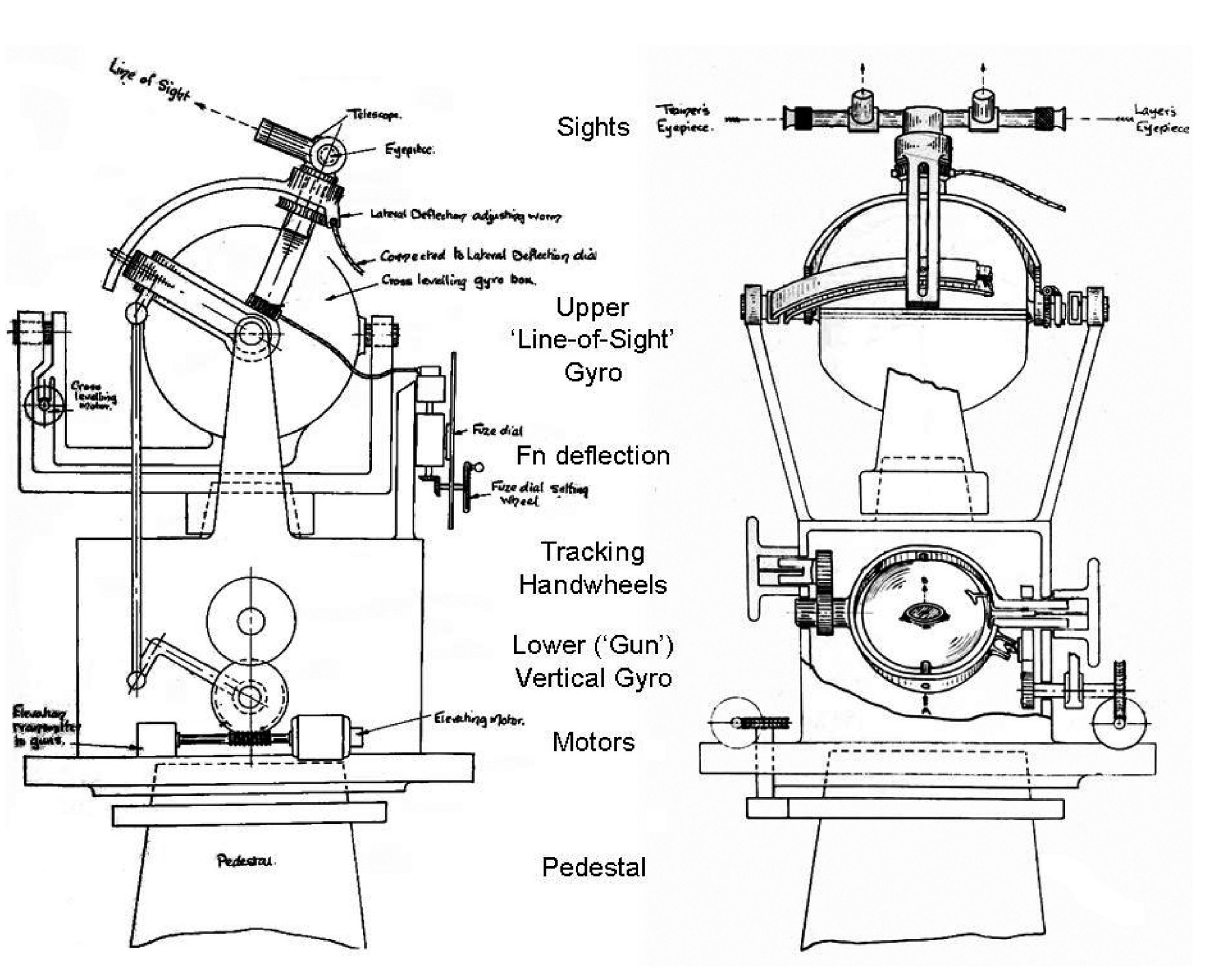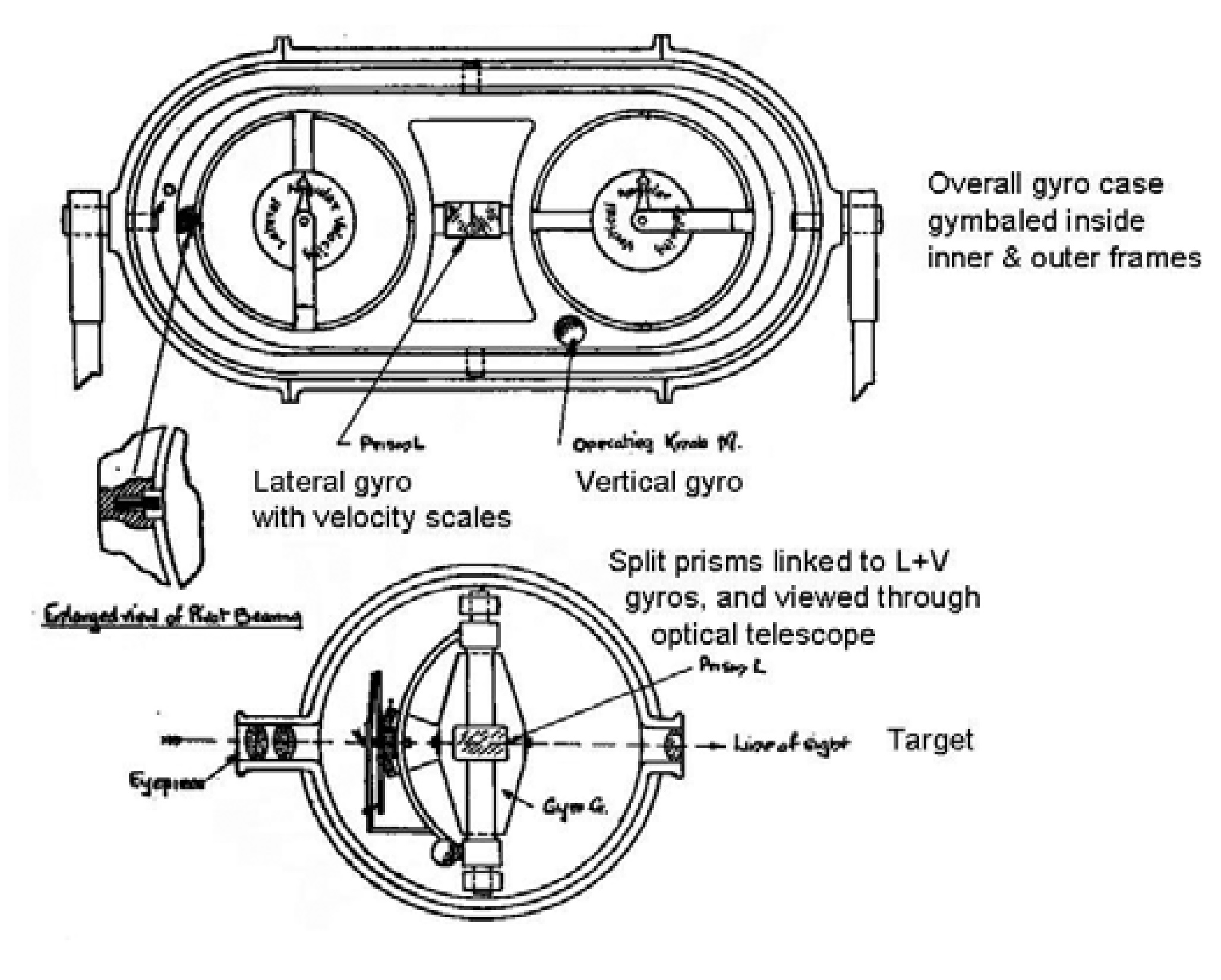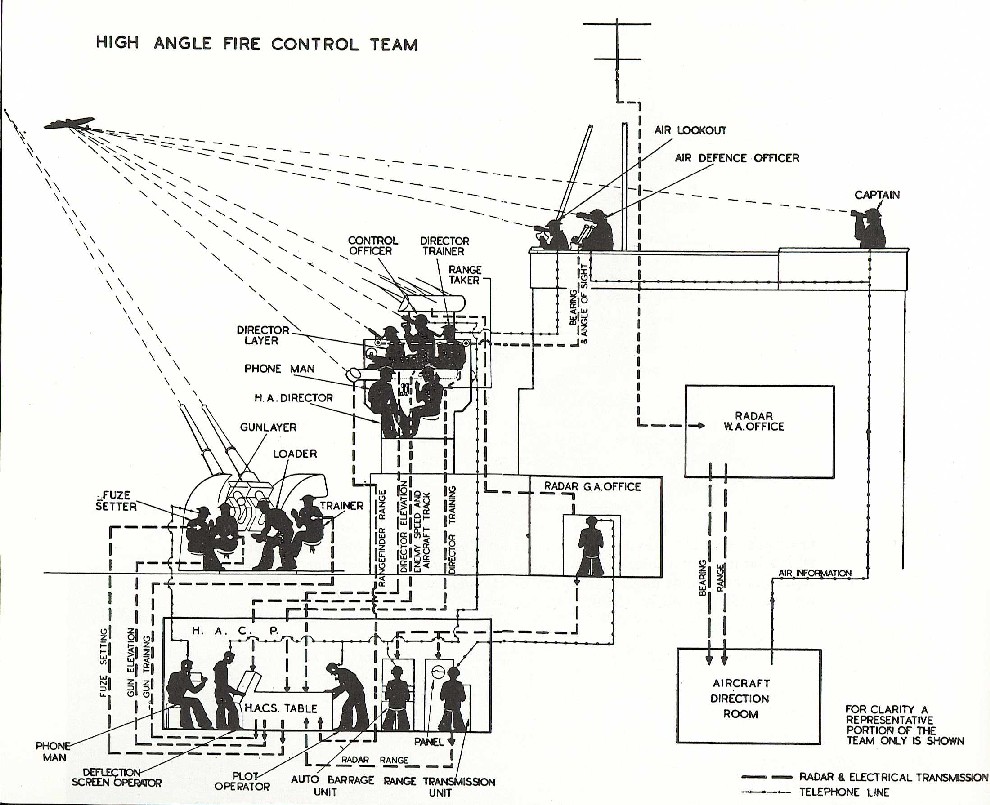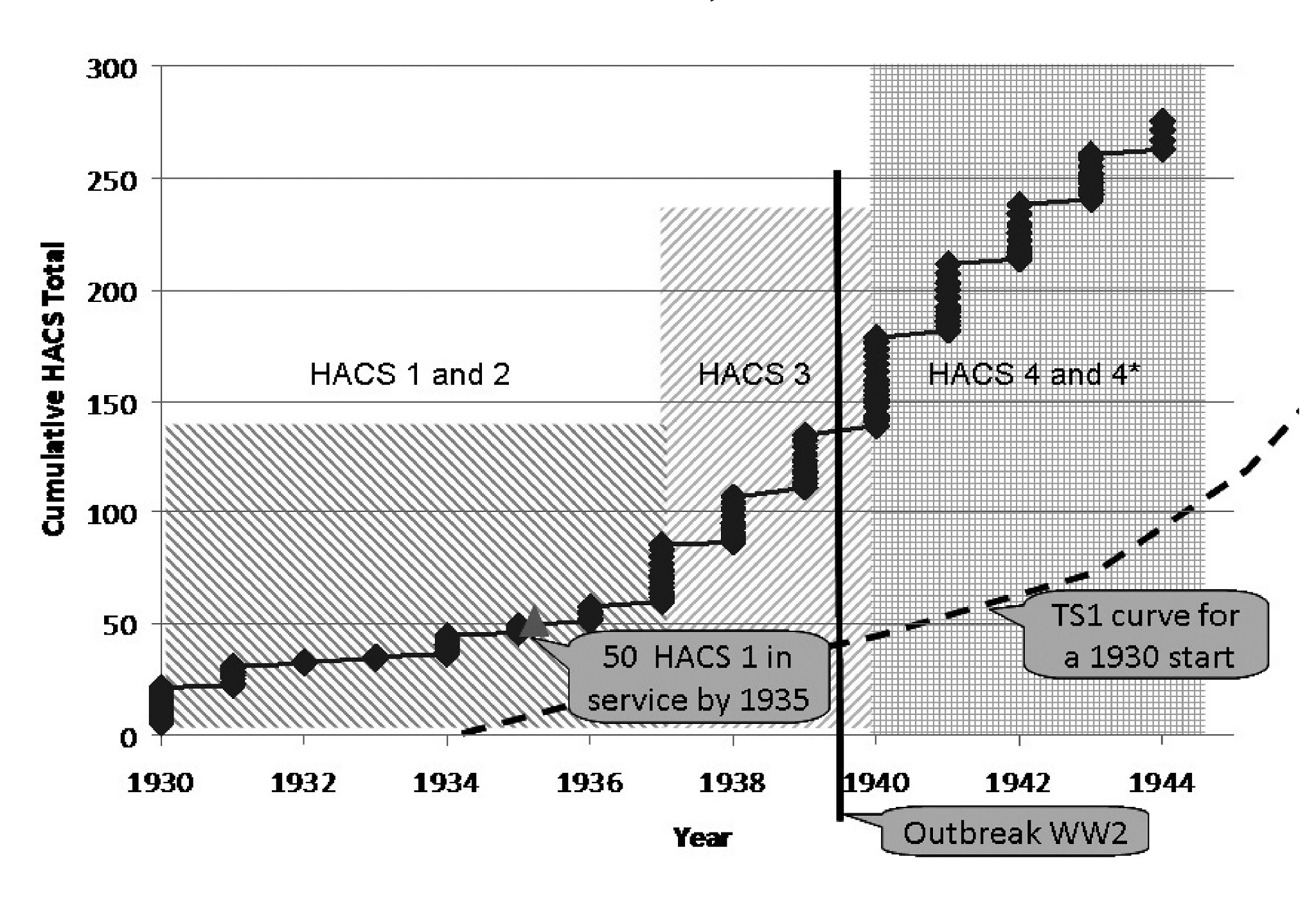Several commentators have criticized the Royal Navy's pre-war High Angle Control System (HACS) as largely ineffectual, and responsible for many of the warships lost to air attack by the German, Italian, and (later) Japanese forces during World War II. In this abridged version of a longer, more technical article that appeared in Warship 2017, the author examines the reasons for this apparent failure.
The pre-war work on anti-aircraft systems for the Royal Navy followed a linear sequence. The Naval Anti-Aircraft Gunnery Committee 1921 (NAAGC'21) was followed by a period of trials and gestation leading to the High Angle Control System Mk 1 (HACS 1). The first production set was trialed by HMS Valiant in January 1930. By 1931, a second NAAGC then addressed 'get-well' issues and focused attention on later technologies. A number of palliative schemes were proposed but development of a planned Tachymetric System Mk 1 (TS 1) was cut short by the transition to war and the need to concentrate production effort on equipment that could be fielded immediately.
HACS was essentially a large-ship system (in cruisers and upwards) plus some specialist conversions. Later, the RN fitted a diminutive version, the Fuse Keeping Clock (FKC), in destroyers and sloops. All these systems shared common characteristics, and by late-war there was a degree of 'crossover' as newer directors were paired with FKC, replacing the HACS table which was no longer being manufactured.
It should be noted that the evidence regarding pre-war decisions made between 1920 and 1939 is extremely fragmented, with many gaps. This means that some conclusions are based on a balance of probabilities. The analysis also contains a degree of hindsight; decisions may well have made sense to the participants at the time.
The NAAGC of 1919-21 was led by Captain C.V. Usborne RN (ADM 186/245 and ADM 7/943). The interim report in 1920 examined 12 predictor schemes; it rejected all of them but noted some strong points for later exploitation. The final report clearly laid out a requirement for control of main high-angle (HA) armament via a director, and evaluated prediction instruments. It recommended a full (or 'ideal') system with a stabilized director sight able to accept estimated inputs to allow initial generation of deflections and fuse length, the approximate results to be updated by a height finder and measured vertical and angular velocities. The paper also identified a less complex system of fire control in single-gun units,and a temporary system for capital ships.
The intent was to conduct early trials in the cruiser HMS Dragon, fitted with four 3in AA guns and a new High Angle Control Position (HACP). This would allow side-by-side comparison of the different instruments. NAAGC'21 recommended the following items:
- Gyro-stabilized director: Henderson AA Director (two-man gyro-stabilized director with sights. An angular velocity (AV) meter was also to be available as a stand-alone instrument. Both were to be supported by a height finder.
- Non-stabilized director: Became Adventure HA/LA director.
- Holland Mk 2 fuse indicator and Col AV Hill fuse predictor.
- HMS Excellent's tachymetric goniograph [an instrument for describing angles] and a Vickers predictor.
The recommendations were implemented (albeit in modified form) by the Admiralty Board (Minute 1537, dated 23 November 1922, in ADM 167/65), and based on the outcome of a conference on 4 October (ADM 167/66). These stated that '. . . owing to the delay that is anticipated in the production of a gyro director, due to its involved nature, development should not be delayed on this account, and [that] action should be taken to develop a director of the non-gyroscopic type.'
Progress in Naval Gunnery (PING) 1923-24 covered interim schemes: the Single Gun-unitSystem (SGS) that improved the 3in AA gun sight, whilst PING'25 described the StandardTemporary System (STS) in capital ships. Not part of STS, and arriving slightly later, was the Adventure director for 4.7in HA/LA guns. This was essentially an stabilized pedestal director with AA sights for the layer and trainer; however, it could transmit orders out to the guns.
The NAAGC'21 report noted that the ideal solution for AA fire control would require a gyro-stabilized HA director, which had been devised by Professor Sir James Henderson and was under design by Vickers. It proposed that one was to be built, to be ready for trials by the end of 1921 (likely to be in HMS Dragon in 1922-23). The subsequent history can be inferred from the annual PING report that followed the trial, stating that a second mock-up embodying considerable alterations had been found necessary. Later reports show:
- April 1924: The only additional trials conducted had been on the AV meter.
- April 1925: The trials previously undertaken in Dragon were now to be carried out in the battlecruiser Tiger. A 'light type' director was mentioned for the first time; other instruments were to be trialed, but the gyro director was not listed.
- April 1926: Light type director made in Excellent, to be ready for trial in Tiger in May 1926.
It is most probably the case that Henderson's director was too late for the 1923 trials and by April 1925 was no longer being considered further. It is likely that this project simply ran out of steam when Professor Henderson's tenure as Admiralty Gyro Adviser was not renewed, and his projects such as the AV meter and the troublesome gunnery gyro were transferred to the Admiralty Research Laboratory (ARL) at Teddington. The next window would have been HMS Tiger in 1926, but the gyroscopic director had been overtaken by Excellent's light type director. The goal of an 'ideal system' based on the gyro director and AV meter was trumped by the Excellent light director and associated predictor elements, which were the effective prototype for what became HACS 1.
The Henderson director would have worked in parallel with both a rangefinder and a fuse predictor. What this director did have was both Line of Sight, and gun (vertical) gyros as part of the structure, with motor follow-ups in elevation, training and cross-level. The layer and trainer manually precessed the gyro cluster so that the director tracked the target. The weak link would have been the simple 'bang-bang' control loops [aka 'On-Off control'], using air-driven 'puffer switches' to drive the DC motors. High-angle work had to accommodate higher and more unpredictable rates than the equivalent low-angle case, and the wartime AA solutions only became effective with AC servos offering fine (proportional) control. Nevertheless, in concept the Henderson director provided the basis of the Gyro Rate Unit Stabilizer which was built some 20 years later.
Henderson's AV meter was initiated in 1919, and first went to sea in early 1923 (ADM 212/62). This used two small gyros, deflected against restraining springs, with sighting prisms for optical tracking (measuring the targets lateral and vertical rates). This was essentially a 'stand-alone' instrument that required a crew of three: a layer, a trainer and a scale reader. The meter trialed in HMS Dragon in 1923 showed early promise; however, later trials showed the need for a redesign as Mk 2. This too suffered from Sir James Henderson's departure and the transfer of the project to ARL; it was re-tried in HMS Tiger in 1926 and 1927 but was overtaken by HACS 1. However, the AV meter was the basis for the much later Gyro Rate Unit.
The Barr & Stroud archives University of Glasgow 1 include a company internal note describing a visit to HMS Tiger on 31 July 1926 for an update on the trials led by Cdr. Simeon and Lt.Cdr Lawrence. The ship had also seen visitors from Elliott's (Sir Keith Elphinstone) and Vickers (Mr Percy Gray). A supplementary note stated that the following week there would be 'trials of the whole gear,' and that B&S would be welcome to attend. This implies that the middle week of August 1926 was the key trial of the complete system, since the firing trials were concluded by the end of August 1926 and the report was received by DNO by the end of September.
The approval of HACS production in 1926 was a joint effort between DNO (Capt C.M. Forbes), DofGD (Capt H.J. Brownrigg), ACNS (RAdm F.C. Dreyer), 3SL/Controller (VAdm E.M. Chatfield), and 1SL/CNS (Adm D.R. Beatty).2 The minutes brim with optimism, based on the Tiger trials report. On 27 October 1926, DNO's comments include the following:
- [It] is a marked step forward on the existing Standard Temporary System…It is certain that by the introduction of the various improvements…a very considerable gain in efficiency will result . . .
- [It will] enable us to improve our existing anti-aircraft fire control systems out of all recognition.
- The installation will be expensive . . . but judging from the glowing tributes paid to the system in the reports, the money will be well spent.
This line was supported by ACNS on 11 November 1926: 'This is a very satisfactory state of affairs as the result of years of labour by many Gunnery Officers.' ACNS proposed that 'Their Lordships' appreciation go to: Cdr C.E.B. Simeon (DofGD staff), who was the first to realize that the HA fire control elements should be interconnected, Capt M.R. Best (the President of the Tiger HA Firing Committee), and the Excellent officers involved in the evolution of the design.3
The executive decision was led by Controller on 15 November 1926 ('Propose to approve . . . I fully concur his minute'), followed by CNS on the 17th ('Approved as per Controller and ACNS'), and finally by Controller on the 18th ('Action accordingly').
PING'26 (ADM 186/271) described the new system as being designed in HMS Excellent, and endeavored to incorporate a director into the existing STS: '[The] opportunity was also taken to interconnect the various instruments and make the whole system as automatic as possible, with a view to reducing lag and the number of operators required' (p50, para 6). The trials report formed Supplement 2 to CB 1602 (pamphlet on HA Firings), recommending that the future system replace STS, leading to a contract to Vickers to design HACS 1 with the following features (p52):
- Director: mounting about the same size as existing main armament director, with undisturbed line-of-sight and with all observing glasses rigidly connected except rangefinder, allowing independent elevation if required; five-man crew (control officer, layer, trainer, rangetaker, and voicepipe man).
- Calculating unit in the TS: deflection gear using optically projected ellipse. The control officer in the director manually set initial target speed, and angle of presentation was fed in from a rotatable graticule in his director sight, aligned with the target's fuselage direction of travel.
- Fuse calculator: improved Hill plotter, working on a Log-Range basis, with an 'aid to plotter' grid to assess the slope of the plot: 'The calculator should also be capable of competing with a climbing or diving target with a fair degree of accuracy'.
- Timing control: accurate application of dead time.
- Stabilizing unit: roll corrector.
- Angle of sight: derived from director, giving continuous and frequent plot at the predictor.
The fitting policy was battleships, battlecruisers, aircraft carriers and cruisers.
Three firms (Barr & Stroud, Elliott's and Vickers) were 'initiated into the secret of HACS', shown the drawings of the prototype system, interviewed, and asked to estimate the cost.4 Once the production contract had been placed, the RN was effectively committed down the HACS 1-4 trajectory for the next ten years, and only contemplated a different system (TS 1) in 1937-38. Roskill 5 reflects some unease by those who took the production decision, but this may also be due to a climate of 'do-something/do-anything' caused by tension over the Treasury's enforced delay to the production order for the 2pdr pom-pom. Neither the original Tiger trial report nor CB1602 Supplement 2 have survived. It is therefore not possible to assess whether the results were over-hyped; however, they clearly captured the imagination of the Naval Staff, from DNO up to the Controller. The evidence of the later acceptance firings (and consideration of the 'excess speed' problem by NAAGC'31) suggest that: either some aspects of the trial did not properly test AA performance (or were glossed over), or that the production system (redesigned and refined by Vickers) had new shortcomings not present in the original Excellent hand-built system trialed in HMS Tiger.
The NAAGC of 1931-32 was the second such committee. The full-time membership included a Rear-Admiral, two Commanders and a 'gunnery officer with practical experience of HACS 1 firings at radio-controlled Queen Bee targets', plus a secretary, and part-time membership of another 11, including representatives from the other services, a Capt A.V. Kerrison (Army, seconded from the War Office), and Mr F. Landucci (technical assistant to DNO). The committee started work on 1 October 1931 and reported on 29 April 1932 (ADM 268/52).
The NAAGC'31 report evaluated a series of 'get-well' modifications to HACS in response to the 'excess speed' problem 6 and a future way-ahead:
- modifications to HACS and a Confidential Admiralty Fleet Order about excess speed;
- the Landucci sight: to be carried forward to trials;
- recommendations for a 'HACS-like' small ships system, which may have initiated FKC.
The report examined nine predictor solutions and also considered five data transmission schemes and three power drives. Pugh 7 believed the NAAGC analysis showed the benefits of tachymetric compared to goniographic systems, but that the Admiralty failed to predict the growth in aircraft capabilities.
E.T. Hanson was the principal ARL Teddington worker on long-range AA prediction from 1922 through to 1934; 8 he was clearly valued and was at the 'top of his game', being an established senior scientific officer who had published four papers in learned journals for optics, physics and maths between 1924 and 1938.
A.V. Kerrison joined Teddington as the Army Liaison Officer in 1934, and later suggested there was only one civilian working on a long-range AA prediction 9 which was subsequently abandoned, and that individual was transferred to other work in another group from 1936. This implies Hanson was first marginalized, then moved on before Kerrison focused on his own No 3 Bofors predictor. However, Hanson was awarded a secret patent (one of three) for improvements to HACS 3 on 28 October 1938 (see ADM 1/9611 for CP Secret patent 8345B/36 for the ARL system of optical projection). After a spell on the staff, Kerrison retired and became its Superintendent from 1940.
The NAAGC'31 report included an examination of tachymetric fire control, and also considered Mr Landucci's scheme 10 for a 'data measuring sight' that worked in the flyplane. Trials by Excellent ran from 1931 through to 1936 but ultimately proved unsuccessful. In 1937, DSR prioritized research as: gunnery gyro compass, gyro rate unit, master stabilizing unit and stabilized sight, and aided laying (ADM 212/174). PING'38 shows that from March 1936 the full rearmament program was launched, seeking to increase annual output by a factor of seven, and was actually achieving five times the 1934 level. The principal difficulties of industrial production in the post-slump environment were:
64. '. . .a shortage of skilled labour and of machine tools . . .'. Another difficulty was the reluctance of established firms to commit capital to an enterprise that might come to naught if world conditions or political opinion changed.
67. The new firms brought in have been manufacturers of such things as gauges, toffee wrapping machines, motorcycles and newspaper printing plant; few of them possess adequate drawing office facilities for constant minor modifications.
68. Supervising and 'nursing' the new firms threw a very heavy load on the technical staff of the Admiralty and, for the moment, development stood still.
83. Tachymetric Aids to Control: 'It is urgently desired to add some form of deflection measuring device to HACS. Sleeve and Queen Bee targets, whose speeds are known within comparatively narrow limits and which cannot vary their speeds appreciably during the run, are apt to breed a false confidence in the adequacy of our deflection control; trials are now going forward to produce some scheme which will aid the control by indicating an approximate by measured deflection.'
For most of the pre-war period, ARL was neither tasked nor staffed to support naval AA fire control development. It did not (until 1927) have a rolling table necessary for such research ashore, though individuals did contribute substantially in the margins of their day job. This left the centre of gravity for such projects to Professor Henderson's gyro group (subsumed into ARL in 1925), DTM's LP & FC section, HMS Excellent's experimental department (XP), and to a lesser extent the Director of Scientific Research (DSR) at the Admiralty, who progressively gained traction across the inter-war period.
Basil Jones11 describes the Home Fleet AA firings in the West Indies against a Queen Bee target in the spring of 1935. His ship (HMS Achilles) was well prepared and worked-up, achieving most bursts within 100 feet of the directly approaching target (photographically flank-marked), but the remainder of the Fleet's results were disappointing.
In March 1936 C-in-C Mediterranean Fleet expressed rising concerns about dive bombing, likely to have been based on first-hand observation of early-model Ju-87 Stukas in the Spanish Civil War. The original NAAGC threat set was slower, and concentrated on torpedo (to be countered by the destroyer screen) and high-level bombing attacks at steady course and speed (HACS with 4in). Dive-bombers attacked at high angles and high rates that were outside the capabilities of early-model HACS or the destroyers' low-angle (<40°) gun mountings. Chatfield and Roskill both wrote about the AA fire control problem. Admiral Chatfield remained complacent until at least May 1936, confidently advising Churchill that 'even one AA gun in a merchant ship would keep the aircraft at a height such that the chance of destroying the ship was very small.' (Roskill Vol 2, 227). A subcommittee of CID, which went under the name of Assessors on Bomb v Battleship Experiments or ABE (Roskill Vol 2, 222 fn 1) was set up in October 1936; deliberations came to a head in 1937 where Home Fleet live firings (October) failed to shoot down a Queen Bee target in 2½ hours. This brought the problems home to the Board and to Chatfield, who then wrote that 'Our present system of HA control is very imperfect' (Roskill Vol 2, 333). ABE was simply too late to influence events, despite citing Kerrison's new tachymetric systems for land service. The Admiralty and DNO effectively missed the opportunity offered by NAAGC'31. Work and the funding available from 1934-36 was concentrated on get-well fixes to HACS and interest in the Landucci sight. The seed-corn was there with Hanson's work on advanced land based AA predictors, but he was marginalized from 1936 onwards, and TS 1 only emerged as a project from 1937.
Pre-war work on Tachymetric System Mk 1 at ARL ran from 1937-40. This would have been a big-ship system, fitted only in cruisers upwards; it was complex, and the core of the director was tested in HMS Coventry in April 1938. The decision to concentrate on immediate war production in 1940 left no new system available in 1942, and led to an awkward gap when HACS was terminated as ineffective. TS 1 would have filled this capability gap; the only palliative measure was the arrival of the US Mk 37 under lend-lease in HMS Delhi in 1942, and then into HMS Vanguard, the 1943 'Battles', and the post-war carriers HMS Eagle and HMS Ark Royal. The other measure was the 'bottom-up' evolution of a new Flyplane system that used electrical technology to by-pass the mechanical computing and oil servo technology so beloved by AGE and DNO.
HACS was based on the premise that the target moved at a constant course, speed and height throughout the engagement. The system was goniographic for lateral and vertical deflections, but also used range rate (a tachymetric process):
- Goniographic (or goniometric) prediction used estimated inputs based on a series of discrete measurements of the target position.
- Tachymetric prediction used continuous measurement of actual target rates, typically using gyro-based instruments.
HACS was therefore about one-third tachymetric, but its solutions were only approximate; performance depended on the Control Officer correcting the fire, based on the position of the earlier bursts with respect to the target, assuming this did not alter course/speed/height, or 'jink'; in many cases this only achieved 'harassing fire'.
The constraints were that the hand-driven HACS director weighed several tonnes, most were not stabilized, optical ranging was difficult, and data feeds relied on somewhat unreliable 'step-by-step' transmissions. The below-decks crew followed input pointers to set the table, leading to lagging errors against crossing targets, and there was no power drive for the gun mountings.
Pre-war the RN regarded bursts within 100 feet (33 yards) as being 'effective', but postwar experiments showed a 4in shell bursting at 45 feet (15 yards) only had a 15 per cent chance of a kill, over quite narrow zones.
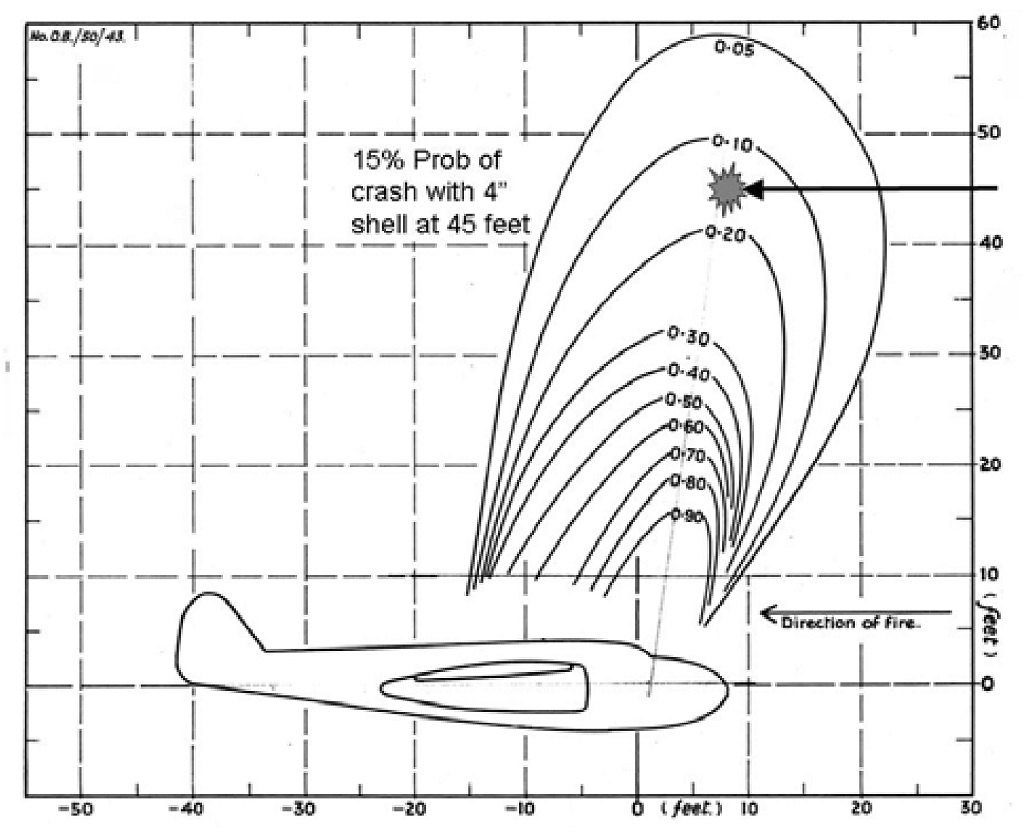
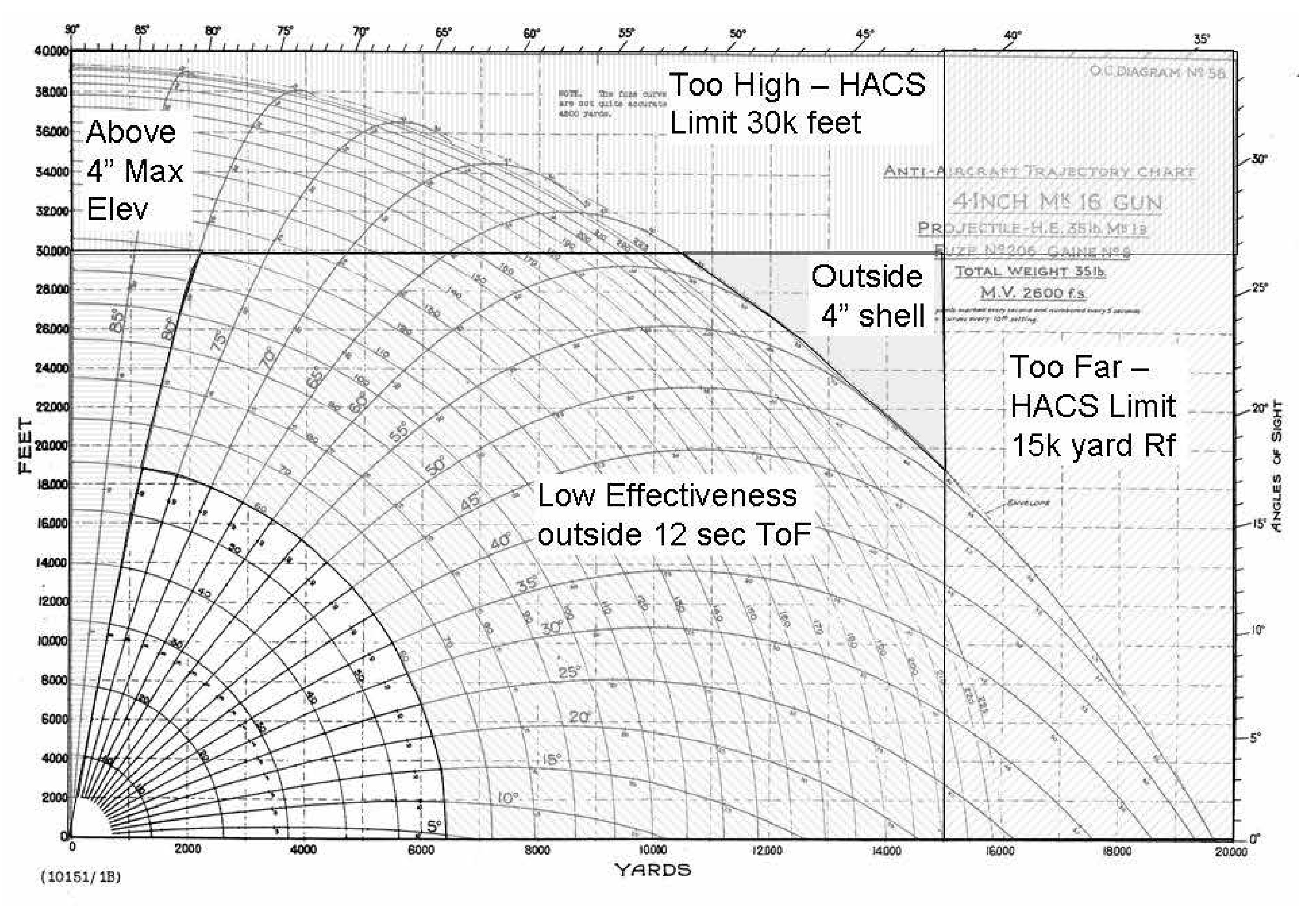
For a larger, more readable version of this graph, please see 4"/45 (10.2 cm) QF HA Marks XVI datapage.
Naval Staff histories describe RN operations from Norway, via Crete and the Mediterranean, through to the Far East. These narratives identify the impact and intensity of enemy air attacks, and highlight that the percentage of AA ammunition remaining became a significant factor in Commanders' decisions. Kew's records include Forms S1515 Report of Enemy Attacks on HM ships (at ADM 199/74 to /1318) but these cannot be collated because the form went through several iterations, and earlier reports usually failed to include the number of rounds expended. In many cases the barrage drove off the attack; RN units in the Channel were facing waves of 21 bombers (supported by up to 10 escorting fighters) and were firing more than 100 rounds each, without necessarily achieving kills. Pout quotes Goering in 1940 as directing his air force to avoid passing close to British warships 'because of the effectiveness of their gunfire' [p95]. Ships' reports were not taken at face value, and the Admiralty often sought corroborative evidence before awarding a formal 'kill'. NHB hold weekly summaries for 1942-5 at Box T3396. Samples show:
- 4-24 Nov 40, HMS Carlisle: series of six separate engagements that expended 470 rounds of 4in. One confirmed kill required 66 rounds, the probable required 69, and the remaining 335 drove off or dissuaded four other attacks.
- 19 Jan 42, HMS Naiad, 249 rounds of 5.25in, mainly driven off.
- 6 Mar 43, HMS Dulverton: 40 rounds of 4in for one kill.
- 12 Dec 44, HMS Bellona: eight rounds of 5.25in for a confirmed kill.
- 29 Jan 45, British Pacific Fleet (three carriers, King George V, two cruisers): total of 367 rounds of 4.5in and 5.25in for six or seven kills (each unit in the force separately claimed 6-7 kills; the Admiralty suspected that in the melee these overlapped). This suggests circa 61 rounds/kill; the ships of the BPF were using VT ammunition, plus close-range weapons.
There are simply too many gaps in the overall records for the first half of the war to allow a 'big average' figure. However, the samples do support Pout's analysis of the late-war effectiveness (HACS 3 or 4 with radar, GRU and VT fuses).
Hugh Clausen and Warrant Officer Porteous appraised the USN Mk 37 system fitted to HMS Delhi during a visit on 24-25 February 1942. Mr Porteous' view was that it was a really well-integrated overall concept, built on a top-down design against a firm specification. However, the US system had shortcomings:
- The computer took time to settle and then generate a solution. There were wartime drill work-arounds to the problem, but these were not promulgated by the USN training organization.
- Postwar, when testing its replacement, errors were discovered in its computer geometry at shorter ranges against crossing targets (attributed to design shortcuts made in the late 1930s).
The evidence suggests that, for all its improvements, HACS was still only one-third to one half as effective as the Mk 37 at longer ranges (although it was significantly improved by VT fuzed shell). HACS was clearly not as good as the Mk 37 at the war's end, but these were the only systems in 'volume' production, and comparisons are therefore appropriate.
HACS went into all battleships, most cruisers, carriers, depot ships and many of the AA conversions. The total was at least 289 installations, spread across 115 ships, plus another 409 installations with the smaller FKC.
The pre-war cost estimate for HACS 4 with GRU was £28,000, whilst postwar records suggest the Mk 37 cost £43,667. As a rough estimate, Mk 37 (which handled both surface and AA targets) was between two and five times more complex than HACS 4 (which only covered AA) when comparing equivalent groups of components.
A key factor in the problems experienced with HACS was the fragmented organizational framework under which development took place. NAAGC'21 and '31 were specially formed panels of 'all the talents' that provided a comprehensive study of problems and solutions, with open-handed treatment of the options. In contrast, the subsequent 'in-house' staffing by D of GD and DNO, covering decisions on what was to be implemented and how the program was to be managed was a deeply flawed process.
In this environment, there was loose coordination between the seniors (1SL/CNS, CofN, ACNS and DNO), but beneath this there was no specialist naval staff and only very skeletal research organizations: ARL/AGE, DTM's LP&FC section and Excellent XP. There are distinct echoes of the limitations of the Torpedo branch described by Franklin, and the need for independent high-level scrutiny.
The Naval Staff focused on the 'here-and-now', buying HACS while under pressure rather than taking a more considered longer-term view. The Admiralty was unlucky: had it delayed, better systems would have become available, but there was no clear driving guiding hand (in contrast to the USN) until the bottom-up development of Flyplane at the end of the war. The RN needed large numbers of systems, and had it delayed there would have been insufficient AA capability at the outbreak of the war.
HACS suffered from being an 'early to market' solution which, once the Navy committed to it, proceeded under its own momentum. With the benefit of hindsight, it is clear that a number of interesting alternatives became available shortly after the Admiralty had committed to a large production program of HACS 1. However, industrial capacity had been stripped out by the depression, and in the recovery phase in the run-up to the Second World War it would have been very difficult either to change direction away from HACS or to adopt a more complex solution like TS 1.
Why did the UK fail with HACS? The decision was based on a spurious comparison of a new (HMS Excellent) solution against an interim (STS) fit, rather than a rigorous assessment of the gyro-based rate measurement instruments which were already part of the sea trials. This decision was not revisited until 1936-37, by which time the shortfalls of HACS were becoming obvious, but the potential 'get-well' program (TS 1) was simply too late for the march to war. Senior staff were blind to the problems, and persisted in their view that all was well.
As conceived in 1926, HACS had several innovative features, but relied on a number of estimated inputs. These shortcomings were cruelly exposed as target speeds increased, and the attack trajectories changed.
HACS was good enough to dissuade high-level bombers such as the Luftwaffe Ju88 or the Regia Aeronautica Savoia, but could not cope with dedicated anti-ship formations such as Fliegerkorps X with the Ju87 Stuka, which caused many of the losses. It was also the case that a more effective RN AA system would have blunted follow-on attacks, rather than allowing the repeated re-attacks within the same day seen in the Mediterranean and on the occasion of the loss of Prince of Wales and Repulse.
Overall, HACS had rather less than half the performance of the USN Mk 37, but cost two-thirds as much. It expended huge amounts of ammunition to little effect. The downside of this false economy was the number ships lost during the intense AA engagements in the Mediterranean and off Malaya.
The USN were able to use 'spiral development' (via Mk's 19-22-33-37) and enjoyed a laxer timeline; in contrast the RN 'flat-lined' with HACS 1-4, driven by the imperative to rearm for war in Europe. In the same period there was no scientific ability to forecast technology trends, and therefore when future solutions might become available.
HACS was both a success and a debacle. It met the 'just-in-time' goal, being produced and fitted in the quantities required for the Second World War, but the technical solution was inadequate and could have been so much better, given the technologies available at the time and those that became available shortly after the main production decision in 1926.
- ^Barr & Stroud archive, correspondence file UGD 295 26/1/21.
- ^'Monthly Record of Important Questions Dealt With by the Director of Naval Ordnance', minutes number 500-526, dated 26 July to 29 June. Held by NHB. See Min 506.
- ^Not identified but likely to have been Excellent's Experimental Department: Cdr C. Moody, Lt-Cdr W. Vaughan Rtd, Lt-Cdr M.M. Denny, Lt-Cdr H. Drew, Lt F.R. Parham, Com Ord Eng W.F.P. Draper and Gunner T.H. Bandy.
- ^DNO Principal Decisions Minute 506: by DNO, 27 Oct 1926, paras 6-9.
- ^Roskill (NR 1977 No. 2, pp. 168-169) cites the unease among naval staff in the know (Lt-Cdr F.E.P. Hutton, HMS Excellent staff, but not in XP) about the wisdom of placing a circa £0.5 million contract for HACS in 1926-27.
- ^Where additional speed (above the target's true speed) had to be set onto the system in order to bring the bursts into line.
- ^Pugh, P.G. 'Managing the Aerial Threat in the Royal Navy 1930-2000', pp. 19-41, in Innovation and Defence, edited by Harding, R. Cass (London 2005).
- ^Three TNA files cover his work as part of the Optics group: ADM 212/51 Notes on AA fire control equipment predictors, 1921-27; ADM 212/72 Notes on Mr E.T. Hanson's Predictor and other fire control problems, 1934; ADM 212/174 Priority of research at Admiralty Research Laboratory Teddington, 1923-37.
- ^Land-based AA (Vickers, Sperry or ARL predictors) was easier because the director and guns were planed-off level, and were static; measured target rates were absolutes, with no ship's motion component.
- ^Pamphlet DNO 53 (December 1931) for Naval HA Control: Proposed 'Basic Rates in Flyplane' Scheme.
- ^Jones, B., 'A Misleading Success', Letter to The Naval Review July 1978, Vol 66 No. 3, pp. 253-255. The DH82B Queen Bee was derived from the Tiger Moth, with a top speed of 95-109 mph and ceiling of 13,600 ft.
RN museums at HMS Excellent (Lt Cdr B. Witts) and HMS Collingwood (Lt Cdr C. Kidd), Naval Historical Branch (Ms J. Wray), Dr J. Brooks, C. Barnett Esq, Glasgow University (Barr & Stroud Archive), and The National Archive (TNA) at Kew.
Chatfield, E., It Might Happen Again Vol 2, Heineman, pp. 33-36 and pp. 45-47 (1947).
Clausen, H., Invention and the Navy, The Naval Review Vol 58 No 5, Oct 1970, pp. 330-337.
Franklin, G.D., A Breakdown in Communications; Britains Over-Estimation of Asdics Capabilities in the 1930s, Mariners
Mirror Vol 84 No 2, pp. 204-214 (1988).
Naval Staff Histories (BR1736 series).
Pout, H.W., Weapon Control in the Royal Navy, in Kingsley, F.A. (Ed), The Applications of Radar and Other Electronic
Systems in the RN in World War Two, pp. 45-146, Naval Radar Trust and Macmillan (London 1995).
Pugh, P.G., Appendix 16: Anti-Air Warfare Between the Wars, in Brown, D.K., From Nelson to Vanguard, pp. 207-209, Chatham
Publishing (London 2000).
Pugh, P.G., Managing the Aerial Threat, in Harding, R. (Ed) The Royal Navy 1930-2000: Innovation and Defence, pp. 19-41,
Cass (London 2005).
Roskill, S.W., Naval Policy Between the Wars, Vol 1, Walker & Co (New York 1968), and Vol 2, Collins (London 1976).
TNA Kew (for ADM referenced files).
Peter Marland is a former RN Weapon Engineer Officer with sea jobs in HM Ships Blake, Bristol and Euryalus, and postings ashore in research and in procurement. He now works as an Operational Analyst, and has contributed a number of articles to Warship on post-war Royal Navy weapons and electronics. He is a Chartered Engineer, with post-graduate qualifications in Project Management and in teaching.
07 May 2020 - New Datapage

